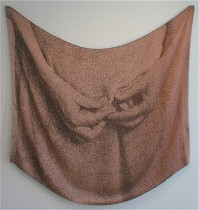
After such a successful First Friday adventure the night before, I headed to Old City Saturday afternoon with thoughts of paint and pixels filling my head.
I started at Temple Gallery‘s “analog click click” group show, curated by Tyler School of Art Assistant Professor of Digital Imaging Sam Fritch.
Once again, the breadth of practice, this time within computer-generated work, nearly crashed my mental computer. Leah Cook’s “Presence/Absence: Gather” (shown above) breaks down the digitized image even further by weaving it into fabric. I liked the way the draped cloth repeated the folds of the worried cloth in the image.
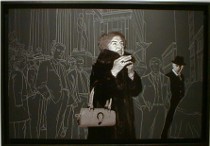 Matt Haffner’s film-noirish meditations (shown right)–computer collages of found and self-portrait photos and hand drawing–seem to parody celebrity and self-absorption.
Matt Haffner’s film-noirish meditations (shown right)–computer collages of found and self-portrait photos and hand drawing–seem to parody celebrity and self-absorption.
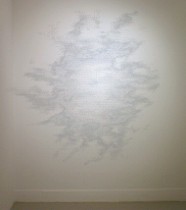 And Cindy Poorbaugh magnifies a tiny pencil mark until the image breaks down the pixels, which she then retranslates into a drawing on the wall, using her own motif–small rectangles (shown, “Blotch”.)
And Cindy Poorbaugh magnifies a tiny pencil mark until the image breaks down the pixels, which she then retranslates into a drawing on the wall, using her own motif–small rectangles (shown, “Blotch”.)
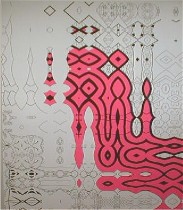
The focus on process permeated all the artists’ work, for better or worse. Carl Fudge plays with the design from an 18th-century Japanese print, using the computer to turn it into pattern then hand painted with intense color (shown right); and Mark Leuders extrudes and turns conceptual blobs of clay on the computer as a prelude to making them in clay (shown below left).
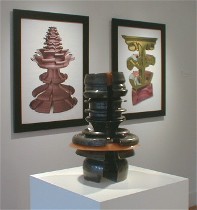 Even the cartoony images of Douglas Boehm seems all process; he scans his drawings and then adds textures from his digital library of patterns (shown below, “Incognito Inmate I.”)
Even the cartoony images of Douglas Boehm seems all process; he scans his drawings and then adds textures from his digital library of patterns (shown below, “Incognito Inmate I.”) 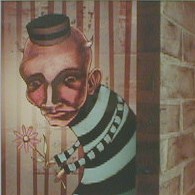
Other artists in the show were E.J. Herczyk, making images from micro bits of film blown up beyond readability and Margo Margolis’ paintings about mark-making, based on borrowings from comic books.
Alas, I’m sad to report that, while the show was quite interesting as a whole, some of the final products didn’t measure up to the computer explorations that created them.
From pixels to painting
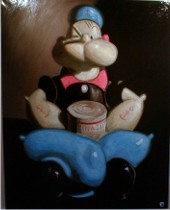 From there I stopped in little Spartaco Gallery, which turns out to be a family operation, in any number of ways. Artist Terrence Laragione, whose show “The Plastic Menagerie” exhibits iconic oils of dramatically lit baby toys viewed from a low perspective (shown, “I Yam What I Yam,”) showed up along with his wife and tiny baby, the toys’ owner, as I was looking around and chatting with his stepmother and keeping my eye on the dog.
From there I stopped in little Spartaco Gallery, which turns out to be a family operation, in any number of ways. Artist Terrence Laragione, whose show “The Plastic Menagerie” exhibits iconic oils of dramatically lit baby toys viewed from a low perspective (shown, “I Yam What I Yam,”) showed up along with his wife and tiny baby, the toys’ owner, as I was looking around and chatting with his stepmother and keeping my eye on the dog.
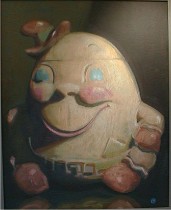 Turns out Laragione and his father own the gallery, which is up the stairs and around the corner from 2nd Street on an alley a little ways north of the Arden Theater. Laragione’s friend Jonathan Collins, a watercolor painter of portraits and landscapes also turned up. The place still smelled like spilled wine from the night before, and it felt warm and friendly (shown, “Before the Fall.”)
Turns out Laragione and his father own the gallery, which is up the stairs and around the corner from 2nd Street on an alley a little ways north of the Arden Theater. Laragione’s friend Jonathan Collins, a watercolor painter of portraits and landscapes also turned up. The place still smelled like spilled wine from the night before, and it felt warm and friendly (shown, “Before the Fall.”)
Collages, real and cyber
I also stopped at Richard Watson’s show at ArtJaz Gallery, a reminder of what the surface of real-world collages look like.
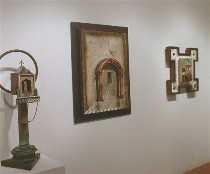 And then I went on to Nexus, which had another new-members show, two of the six doing guess what? Yup, computer collages.
And then I went on to Nexus, which had another new-members show, two of the six doing guess what? Yup, computer collages.
Best of show, however, was real world work from Gwendolyn Fryer, altar-like sculptural collages of rescued building materials, Arabic calligraphy and painting. (shown left above and right).
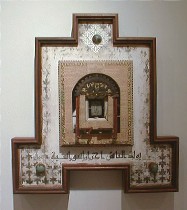 The work was instantly recognizable as coming from an artist whose work I’d seen four years earlier at the University City Science Center. Turns out Fryer had spent some of her childhood growing up in Libya as the daughter of a petroleum geophysicist. The pieces suggest layers of civilization, layers of geography, with cool interiors behind peeling walls–the architecture of North Africa, the Arabian Peninsula and the Dome of the Rock.
The work was instantly recognizable as coming from an artist whose work I’d seen four years earlier at the University City Science Center. Turns out Fryer had spent some of her childhood growing up in Libya as the daughter of a petroleum geophysicist. The pieces suggest layers of civilization, layers of geography, with cool interiors behind peeling walls–the architecture of North Africa, the Arabian Peninsula and the Dome of the Rock.
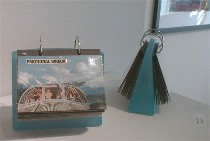 Elizabeth New, who showed a small selection of her large-size digital photocollages–images plus words–on the wall, had a nice display of postcard-size versions in standup binders (see image). The small scale seemed just right for their one-liner messages.
Elizabeth New, who showed a small selection of her large-size digital photocollages–images plus words–on the wall, had a nice display of postcard-size versions in standup binders (see image). The small scale seemed just right for their one-liner messages.
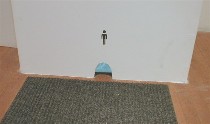 Other photocollages came from Catherine Passante. Between the hard-to-parse words on the wall and the confusion of images, I was, well, confused. But I was not confused by super-saturated iconic soft-drink bottles from Matthew Brownell–too much like the advertising they seemed to be mocking. Jodie Sweitzer offered a mousehole-embedded pair of videos of feet in the men’s and women’s rooms (shown). And Tom McCloskey offered steel blades embedded in beeswax and a very Catholic altar buzzing with bees.
Other photocollages came from Catherine Passante. Between the hard-to-parse words on the wall and the confusion of images, I was, well, confused. But I was not confused by super-saturated iconic soft-drink bottles from Matthew Brownell–too much like the advertising they seemed to be mocking. Jodie Sweitzer offered a mousehole-embedded pair of videos of feet in the men’s and women’s rooms (shown). And Tom McCloskey offered steel blades embedded in beeswax and a very Catholic altar buzzing with bees.









